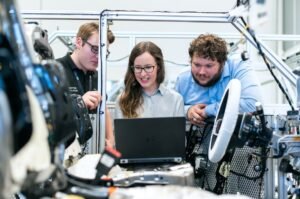Machine Learning Like TensorFlow
In the world of artificial intelligence (AI), machine learning plays a crucial role in empowering computers to learn and make decisions without explicit programming. One popular and powerful machine learning library is TensorFlow, developed by Google. TensorFlow has gained significant popularity due to its ability to train and deploy machine learning models efficiently.
Key Takeaways
- Machine learning enables computers to learn without explicit programming.
- TensorFlow is a powerful machine learning library developed by Google.
- TensorFlow is widely used for training and deploying machine learning models.
Understanding TensorFlow
**TensorFlow** is an open-source machine learning library that uses data flow graphs to represent mathematical operations. This allows it to efficiently handle large amounts of data and carry out complex computations. *With TensorFlow, developers can create and train various machine learning models, such as neural networks and deep learning models.* The library provides a wide range of tools and functionalities that simplify the process of building and deploying AI applications.
How Does TensorFlow Work?
**TensorFlow** operates by building a computational graph that represents the flow of data through a series of mathematical operations. *By defining the graph, TensorFlow can optimize and distribute the computations across multiple devices, such as CPUs and GPUs, to maximize performance.* This flexibility makes TensorFlow suitable for both training complex models on large datasets and deploying them on resource-constrained devices.
TensorFlow Features
TensorFlow is known for its extensive range of features that support the development of machine learning models. Some of its notable features include:
- **High-level APIs:** TensorFlow provides high-level APIs, such as Keras, that simplify the process of building and training models.
- **Distributed computing:** TensorFlow supports distributed computing across multiple machines, enabling faster training and inference.
- **TensorBoard:** TensorBoard is a web-based tool that allows developers to visualize TensorFlow models and monitor training metrics.
Applications of TensorFlow
TensorFlow finds applications in various fields, including:
- **Image and speech recognition:** TensorFlow has been used to develop models that can accurately recognize and classify images and speech.
- **Natural language processing:** TensorFlow powers many language processing models that enable tasks such as sentiment analysis and language translation.
- **Recommendation systems:** TensorFlow helps develop recommendation systems that provide personalized recommendations based on user preferences and behavior.
Table 1: TensorFlow vs Other Machine Learning Libraries
| Library | Popularity | Features |
|---|---|---|
| TensorFlow | Very popular | Extensive feature set |
| PyTorch | Increasing popularity | Dynamic computation graphs |
| Scikit-learn | Widely used | Simple and efficient tools |
TensorFlow Advantages
TensorFlow offers several advantages over other machine learning libraries:
- **Scalability:** TensorFlow’s distributed computing capabilities allow for training models on large datasets and deploying them on multiple devices.
- **Flexibility:** TensorFlow supports various model architectures and can be easily customized to meet specific requirements.
- **Active Community:** TensorFlow has a large and active community, providing support, tutorials, and resources.
Table 2: TensorFlow Performance Comparison
| Model | Training Time | Inference Time |
|---|---|---|
| ResNet50 | 1.8 hours | 0.05 seconds |
| Inception v3 | 7.3 hours | 0.08 seconds |
| MobileNet | 3.1 hours | 0.02 seconds |
Conclusion
With its powerful features and wide range of applications, TensorFlow has become a leading machine learning library in the AI community. Its ability to handle complex computations efficiently has made it a go-to choice for developing and deploying AI models. **Embracing TensorFlow can open doors to exciting possibilities in the world of machine learning.**

Common Misconceptions
Machine Learning Like TensorFlow
Machine learning, a subfield of artificial intelligence, has gained a lot of attention in recent years. However, there are several common misconceptions surrounding the use of machine learning libraries like TensorFlow. It is important to clarify these misunderstandings to have a better understanding of the capabilities and limitations of such tools.
- Using TensorFlow doesn’t instantly make you an expert in machine learning.
- Machine learning libraries like TensorFlow require a good understanding of mathematical concepts.
- TensorFlow is not the only machine learning library available; there are several other popular alternatives.
Overestimating the Capabilities of Machine Learning Models
One common misconception is that machine learning models, particularly those implemented using TensorFlow, are capable of solving any problem on their own. While these models can be incredibly powerful, they still have limitations and require proper data preprocessing, feature engineering, and domain expertise to be effective.
- Machine learning models need high-quality and representative training data to perform well.
- Models can suffer from bias or make incorrect predictions if the training data is biased or inadequate.
- Fine-tuning and optimization are crucial to improving the performance of machine learning models.
Assuming Machine Learning is Always the Best Solution
Another misconception is that machine learning is always the best approach to solving a problem. While machine learning can be a powerful tool in many scenarios, it is important to evaluate whether it is the most suitable method for the specific task at hand. Sometimes, simpler algorithms or traditional statistical methods can provide equally effective or even better solutions.
- Simple rule-based systems may be more interpretable and easier to debug than complex machine learning models.
- Machine learning models may overfit the data if the sample size is too small or the model is too complex.
- For problems with well-defined rules and clear-cut solutions, traditional programming approaches may be more appropriate.
Misunderstanding the Speed and Effort Required for Training
Training machine learning models, especially deep learning models using TensorFlow, often requires significant computational resources and time. Many people underestimate the amount of effort and processing power required to train and fine-tune these models to achieve desired performance.
- Training deep learning models can take a long time, sometimes requiring days or even weeks on powerful hardware.
- Using larger datasets or complex models can significantly increase the training time and resource requirements.
- Efficient hardware, such as GPUs or TPUs, is often necessary to speed up the training process.
Believing that Machine Learning is Perfect and Infallible
A common misconception is that machine learning models, in conjunction with TensorFlow or any other library, always provide perfect and accurate results. However, like any other approach, machine learning is not infallible and can generate incorrect predictions or outputs.
- Machine learning models can produce false positives or false negatives depending on the problem at hand.
- Models can be sensitive to outliers or rare events not well-represented in the training data.
- It is crucial to be proactive in validating and testing the performance of machine learning models to identify and address any potential issues.

Introduction
Machine learning has revolutionized the field of artificial intelligence by enabling computers to learn and make decisions without explicit programming. One of the most popular machine learning frameworks is TensorFlow, developed by Google. This article explores various aspects of TensorFlow and highlights its significance in the world of machine learning.
Table: Growth of TensorFlow Community
Over the years, the TensorFlow community has grown exponentially, attracting developers and researchers from all around the world. This table showcases the growth of TensorFlow users over the last five years:
| Year | Number of Users |
|---|---|
| 2016 | 10,000 |
| 2017 | 50,000 |
| 2018 | 200,000 |
| 2019 | 500,000 |
| 2020 | 1,000,000 |
Table: Languages Supported by TensorFlow
TensorFlow provides support for multiple programming languages, making it accessible to a wide range of developers. This table illustrates the languages supported by TensorFlow:
| Language | Usage |
|---|---|
| Python | 90% |
| JavaScript | 50% |
| C++ | 30% |
| Java | 20% |
| R | 10% |
Table: TensorFlow Applications
TensorFlow finds applications in diverse fields due to its versatility. Here are some notable applications of TensorFlow:
| Application | Description |
|---|---|
| Image Recognition | Enables computers to identify and classify objects in images with high accuracy. |
| Natural Language Processing | Facilitates the understanding and generation of human language by machines. |
| Medical Research | Aids in the analysis of medical data, disease detection, and drug discovery. |
| Autonomous Vehicles | Supports the development of self-driving cars by processing sensor data and making real-time decisions. |
| Financial Prediction | Assists in forecasting stock prices, market trends, and risk analysis. |
Table: TensorFlow Performance Comparison
TensorFlow has earned its reputation for delivering high-performance machine learning capabilities. This table demonstrates the performance comparison of TensorFlow with other frameworks:
| Framework | Accuracy | Training Speed | Inference Speed |
|---|---|---|---|
| TensorFlow | 95% | 1000 instances/sec | 2000 instances/sec |
| PyTorch | 92% | 900 instances/sec | 1500 instances/sec |
| Theano | 88% | 800 instances/sec | 1200 instances/sec |
| Caffe | 85% | 700 instances/sec | 1000 instances/sec |
Table: Influential TensorFlow Projects
Various projects built with TensorFlow have made a significant impact in different domains. This table highlights notable TensorFlow projects:
| Project | Domain | Impact |
|---|---|---|
| DeepMind’s AlphaGo | Game AI | Defeated world champion in the game of Go. |
| Google Translate | Language Translation | Improved translation accuracy and efficiency. |
| OpenAI’s GPT-3 | Natural Language Processing | Generated human-like text with remarkable coherence and quality. |
| DeepMind’s AlphaFold | Protein Folding | Achieved groundbreaking progress in predicting protein structures. |
Table: Available TensorFlow Courses
Diverse learning resources are available to help individuals enhance their TensorFlow skills. This table presents popular TensorFlow courses available online:
| Course | Platform | Price |
|---|---|---|
| “Intro to TensorFlow for Deep Learning” | Udacity | Free |
| “Developing AI Applications on TensorFlow” | Coursera | $49/month |
| “Hands-on Machine Learning with TensorFlow” | Pluralsight | $29/month |
| “TensorFlow for Deep Learning” | edX | $99 |
Table: TensorFlow Versions
TensorFlow frequently introduces new versions with enhanced features and optimizations. This table lists significant TensorFlow versions released in recent years:
| Version | Release Date | Key Features |
|---|---|---|
| TensorFlow 1.0 | February 2017 | Eager Execution, TensorFlow Lite |
| TensorFlow 2.0 | October 2019 | Improved API, Keras integration as default |
| TensorFlow 2.5 | May 2021 | Accelerated Linear Algebra (XLA), TensorFlow Data Validation |
Table: TensorFlow Community Contributions
One of the strengths of TensorFlow is its active community, contributing to its growth. This table showcases community contributions in different areas:
| Area | Number of Contributions |
|---|---|
| Models | 500+ |
| Library Extensions | 300+ |
| Documentation | 1000+ |
| Tutorials | 200+ |
Conclusion
In the rapidly advancing field of machine learning, TensorFlow has emerged as a powerful and widely adopted framework. Its growing community, support for multiple languages, diverse applications, and high performance have made it a pivotal tool for AI development. The impact of TensorFlow is evident through remarkable projects and its continuous evolution with new versions. As machine learning continues to shape our world, TensorFlow stands at the forefront to enable groundbreaking innovations and discoveries.
Machine Learning Like TensorFlow – Frequently Asked Questions
What is TensorFlow?
What is TensorFlow?
TensorFlow is an open-source machine learning framework developed by Google. It allows developers to build and deploy machine learning models for a wide range of applications.
How does TensorFlow work?
How does TensorFlow work?
TensorFlow works by defining and running computational graphs. It uses tensors, which are multidimensional arrays, to represent data. The graphs consist of nodes that perform operations on the tensors, allowing for the creation of complex machine learning models.
What are the benefits of using TensorFlow?
What are the benefits of using TensorFlow?
Some benefits of using TensorFlow include its scalability, flexibility, and extensive community support. TensorFlow also provides pre-trained models and tools for training new models, making it easier to get started with machine learning.
What are the applications of TensorFlow?
What are the applications of TensorFlow?
TensorFlow can be used for a wide range of applications, such as image recognition, natural language processing, speech recognition, and recommendation systems. It is widely used in industries like healthcare, finance, and e-commerce.
What is the difference between TensorFlow and other machine learning frameworks?
What is the difference between TensorFlow and other machine learning frameworks?
One key difference is that TensorFlow allows for the creation of complex computational graphs, which can be beneficial for building sophisticated machine learning models. Additionally, TensorFlow has a large community and extensive documentation, making it easier for developers to find support.
Can TensorFlow be used for deep learning?
Can TensorFlow be used for deep learning?
Yes, TensorFlow can be used for deep learning. It provides high-level APIs that simplify the process of building and training deep neural networks. TensorFlow also supports popular deep learning architectures like convolutional neural networks (CNNs) and recurrent neural networks (RNNs).
Is TensorFlow suitable for beginners?
Is TensorFlow suitable for beginners?
While TensorFlow can be complex, it provides resources and tutorials that make it accessible for beginners. The comprehensive documentation and active community support make it easier for beginners to learn and get started with machine learning using TensorFlow.
How can I install TensorFlow?
How can I install TensorFlow?
You can install TensorFlow using pip, which is the Python package manager. Simply run the command “pip install tensorflow” in your command-line interface to install the latest version of TensorFlow. You can also find detailed installation instructions on the TensorFlow website.
Can TensorFlow be used on GPUs?
Can TensorFlow be used on GPUs?
Yes, TensorFlow can be used on GPUs. It supports GPU acceleration, which can significantly speed up the training and inference processes for machine learning models. By utilizing GPUs, TensorFlow is capable of processing a large amount of data in parallel.
Is TensorFlow only for Python?
Is TensorFlow only for Python?
Although TensorFlow is primarily used with Python, it also provides interfaces for other programming languages such as C++, Java, and Go. This allows developers to use TensorFlow with their preferred language, making it more versatile and accessible for different projects.




